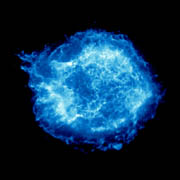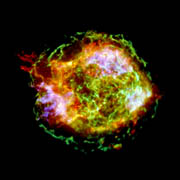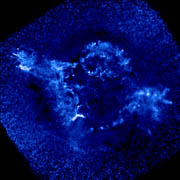|
|
Imagine the Universe Focuses On...
 Archive of Previous Focus On...Topics
Archive of Previous Focus On...Topics
There are many fascinating objects in the Universe. They come in all
shapes and sizes. Each month, we will focus on one of these objects in detail.
Will will present what it is, how scientists believe it was created and evolved into its current state, and what scientists believe will eventually become
of it. We will also discuss any implications or insights to the Universe as a whole that the object may have provided to scientists.
Focus On...
Cassiopeia A
Through a series of observations in 2004, the Chandra X-ray Observatory accumulated a million seconds of observations on
Cassiopeia A, a remnant of a supernova explosion. Cas A was the
first object Chandra observed, and it has continued to probe ever
deeper into its structure and composition. These new observations
were arranged by Una Hwang of Goddard Space Flight Center.
The three color image (below, center) shows an outer ring (enhanced
in green via the color coding of the energies) that marks the location of
the shock wave generated by the supernova explosion. A large,
jet-like structure protruded beyond the shock
wave to the upper left. Surprisingly, X-ray spectra show that the jet
has relatively large amount of silicon and low amount of iron. The
cause for this is part of on-going detailed studies. In
addition, enhancing the image to show just the silicon (below, right)
reveals a counter-jet to the lower right.
Iron, however, is present in the remnant. The bright blue region just
inside the shock wave on the lower left is composed of iron gas. It
was somehow ejected in a direction almost perpendicular to the
jets.
One curious feature of Cas A is that the central neutron star (visible
in the broadband image, below left) is quiet, unlike the pulsars that
lie in the center of the Crab nebula and the Vela supernova remnant.
A working hypothesis is that the explosion that created Cassiopeia A
produced high-speed jets similar to but less energetic than the
hypernova jets thought to produce gamma-ray bursts. During the
explosion, the neutron star may have developed an extremely strong
magnetic field that helped to accelerate the jets. This strong
magnetic field later stifled any pulsar wind activity, so the neutron
star today resembles other strong-field neutron stars
(a.k.a. "magnetars") in lacking a pulsar wind nebula.



Million-second observation of Cassiopeia
A taken by the Chandra X-ray Observatory in 2004. Left: A broadband X-ray image showing the remnant in the Chandra
X-ray range of 1.75 - 7.0 keV. Center: An image of the remnant color
coded by energy: Red represents X-rays from 1.78-2.0 keV;
Green=4.2-6.4 keV; Blue=6.52-6.95 keV. Right: An image enhanced to
emphasize the location of silicon in the remnant. Each image is 8
arcminutes on a side. (Credit: NASA/CXC/GSFC/U. Hwang et al.)
Source: ChandraX-ray Observatory (http://chandra.harvard.edu/photo/2004/casa/)
|
